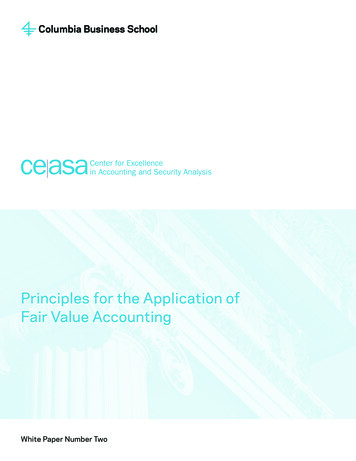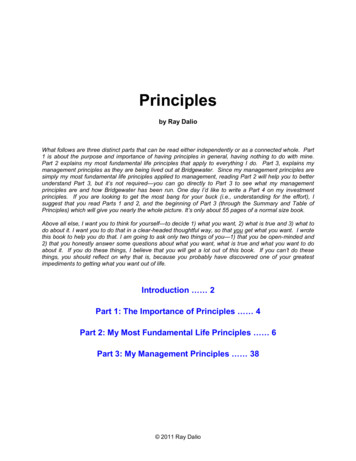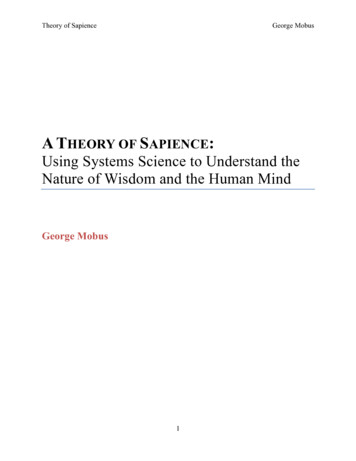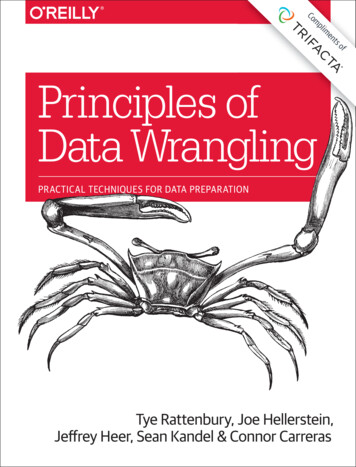
Transcription
Principles for the Application ofFair Value AccountingWhite Paper Number Two
Center for Excellence in Accounting & Security AnalysisColumbia Business School established the Center for Excellence in Accounting and SecurityAnalysis in 2003 under the direction of Trevor Harris and Professor Stephen Penman. TheCenter (“CEASA”) aims to be a leading voice for independent, practical solutions forfinancial reporting and security analysis, promoting financial reporting that reflects economicreality and encourages investment practices that communicate sound valuations.CEASA’smission is to develop workable solutions to issues in financial reporting andaccounting policy; produce a core set of principles for equity analysis; collect and synthesizebest thinking and best practices; disseminate ideas to regulators, analysts, investors,accountants and management; and promote sound research on relevant issues. Drawing onthe wisdom of leading experts in academia, industry and government, the Center producessound research and identifies best practices on relevant issues. CEASA's guiding criterion isto serve the public interest by supporting the integrity of financial reporting and theefficiency of capital markets.Located in a leading university with a mandate for independent research, CEASA ispositioned to lead a discussion of issues, with an emphasis on sound conceptual thinking andwithout obstacles of constituency positions.More information and access to current research is available on our website athttp://www.gsb.columbia.edu/ceasaThe Center is supported by our generous sponsors: General Electric, IBM and MorganStanley. We gratefully acknowledge the support of these organizations that recognize theneed for this center.
PRINCIPLES FOR THE APPLICATION OF FAIR VALUEACCOUNTINGProject Investigators:Doron Nissim; Professor, Columbia Business School; Chair of the AccountingDepartment, Columbia Business SchoolStephen Penman; George O. May Professor of Accounting, Columbia BusinessSchool; Co-Director, CEASAJuly 2008This paper does not necessarily reflect the views of the Center’s Advisory Board or the Center’ssponsors.
Table of ContentsOVERVIEW.II.INTRODUCTION TO THE FAIR VALUE ACCOUNTING ISSUE . 1WHAT IS FAIR VALUE ACCOUNTING? . 3FAIR VALUE FOR WHOM? . 5THE APPROACH IN THE PAPER . 7LIMITATIONS OF THE PAPER. 9OUTLINE OF THE PAPER . 11II. PRODUCT FEATURES OF FAIR VALUE ACCOUNTING AND HISTORICAL COSTACCOUNTING. 12PROPERTIES OF IDEAL FAIR VALUE ACCOUNTING FOR SHAREHOLDERS . 13PROPERTIES OF IDEAL HISTORICAL COST ACCOUNTING . 14THE DEMAND FOR FAIR VALUE ACCOUNTING AND HISTORICAL TRANSACTIONS ACCOUNTING . 17III. FIVE PRINCIPLES. 21A.B.C.D.E.F.G.THE ONE-TO-ONE PRINCIPLE: FAIR VALUES REPORT VALUE TO SHAREHOLDERS ONLY WHEN SHAREHOLDERS’ WELFARE ISDETERMINED SOLELY BY EXPOSURE TO MARKET PRICES . 23THE MATCHING PRINCIPLE: FAIR VALUE APPLIES TO AGGREGATED ASSETS AND LIABILITIES EMPLOYED TOGETHER . 28THE INFORMATION CONSERVATION PRINCIPLE: WHEN ACCOUNTING INFORMS ABOUT PRICE, PRICE CANNOT INFORM THEACCOUNTING . 32THE NO-ARBITRAGE ESTIMATION PRINCIPLE: “FAIR” VALUE ESTIMATES OBEY NO-ARBITRAGE PRINCIPLES WITH RESPECTTO OBSERVED PRICES . 35THE TRUING-UP PRINCIPLE: TO BE “FAIR,” ACCOUNTING FOR FAIR VALUES TRUES UP AGAINST ACTUAL TRANSACTIONS 40TYING THE PRINCIPLES TOGETHER . 40A UNIFYING PRINCIPLE: THE ECONOMICS OF ARBITRAGE . 42IV. PRACTICAL CONSIDERATIONS IN APPLYING FAIR VALUE ACCOUNTING . 44APPROXIMATE FAIR VALUE ACCOUNTING . 44SUPPLEMENTARY DISCLOSURE . 45APPLYING FAIR VALUES UNDER HISTORICAL COST ACCOUNTING . 46V.LEARNING FROM MARKET SOLUTIONS . 48VI. SUMMARY: WHEN FAIR VALUE ACCOUNTING IS APPLICABLE. 51VII. REPORTING FAIR VALUES FOR DIFFERENT INDUSTRIES . 53BALANCE SHEET AND INCOME STATEMENT PRESENTATION . 53FAIR VALUE ACCOUNTING FOR A NON-FINANCIAL FIRM . 56FAIR VALUE ACCOUNTING FOR BANKS . 58FAIR VALUE ACCOUNTING FOR INSURANCE COMPANIES . 58APPENDIX A: STATEMENTS FOR AND AGAINST FAIR VALUE ACCOUNTING . 61APPENDIX B: AN EXAMPLE OF VALUATION UNDER HISTORICAL TRANSACTIONSACCOUNTING. 75
OverviewThis paper, the second in CEASA’s White Paper series on accounting issues, lays out principles underwhich fair value accounting satisfies the objective of reporting to shareholders. Its “principles-based”approach embraces broad economic concepts but is also pragmatic and specific enough to guidepractice. Accordingly, the pros and cons of fair valuing bank loans, core deposits, inventories,investments in subsidiaries, insurance contracts, performance obligations, and debt, to name a fewbalance sheet items, are addressed. Financial statements for reporting fair values in selected industriesare proposed at the end of the paper.Under the principles of the paper, fair value accounting for non-financial firms is largely limited toassets and liabilities associated with financing activities. For assets and liabilities employed in thebusiness, fair value accounting typically fails to meet the principles because, under the business model,value is added by successfully transacting in markets rather than from fluctuations in market pricesdirectly. Exceptions involve cases where the business model involves holding rights and obligationswhose values vary one-for-one with market prices. The application of fair values is a little morecomplicated in the case of financial institutions where so-called financial assets and liabilities areemployed in the business. But the same principles apply such that fair value is again appropriate whenthe value of these assets and liabilities varies directly with market prices rather than from their use ingaining customers.Two considerations confine the discussion in the paper. First, fair value accounting is evaluated for thepurpose of reporting to shareholders. Second, the fair value measure entertained is “exit value,” asadopted recently by the Financial Accounting Standards Board (FASB) in Statement 157 andentertained in discussion papers of the International Accounting Standards Board (IASB). The firstpoint forces the analysis to be pragmatic, focusing on the practical tasks of valuation and stewardshipassessment: To what extent does fair value accounting aid or frustrate equity valuation and monitoringof management? The second engages the current debate: While the recent FASB Statement 157 dealswith how fair value is to be measured – as exit value – the issue of when fair values should be appliedis unresolved.In discussions of fair value accounting, “historical cost accounting” is typically assumed to be thedefault. In differentiating it from fair value accounting, historical cost accounting is better referred toas “historical transactions accounting” for it is based on reporting value added from markettransactions rather than from fluctuations of market prices (without transactions). The paper beginswith an analysis of how both fair value accounting and historical cost accounting in principle satisfythe valuation and stewardship objectives of reporting to shareholders. Advocates of fair valueaccounting often misconstrue historical cost (transactions) accounting, dismissing it as reporting “oldcosts” rather than current values. The analysis demonstrates how historical transactions accounting –with its emphasis on the income statement – works to inform about current value (for shareholders),and at the same time shows how fair value accounting – with its balance sheet emphasis – also does so.The analysis instructs the equity analyst for it shows that fair value financial statements are handledquite differently from historical cost statements in equity valuation. For example, while fair valueaccounting reports a balance sheet that is informative about value, it renders an income number that isuninformative about that value. However, the income statement reports on value at risk.Center for Excellence in Accounting & Security Analysis i
With an understanding of how both fair value accounting and historical transactions accounting workfor valuation and stewardship reporting in principle, the paper then turns to the issue of measurement.Measurement is, of course, the rub of accounting and good concepts sometimes fall against thedemands of measurement. The FASB requirement that fair value have some objective basis – backedup by a market price – invokes a desirable measurement standard, and is endorsed. But under whatcircumstances does fair value as exit value enhance or frustrate equity valuation and stewardshipassessment?Here are the core ideas around which the prescriptions in the paper are built. The first three principlespertain to the case where prices are available in liquid markets and the last two add considerations forthe case where fair values must be estimated.The One-to-One Principle. Fair value accounting is sufficient for shareholder reporting whenshareholder value depends solely on exposure to market prices; that is, assets and liabilities areappropriately marked to fair value only when shareholder value varies one-to-one with the marketprice of those assets or liabilities. This principle means that fair value accounting is not strictlyappropriate when a firm adds value to the market price through its business enterprise. So, forexample, fair value accounting is appropriate for a trading security where shareholder value isdetermined, dollar-for-dollar, by the change in its market price. However, fair value accounting is notappropriate for raw materials where the value (to shareholders) depends not on the market price of theraw materials but on their use, in combination with other inputs, to produce a product that is then soldwith value added over the market price of the raw materials. Core bank deposits do not satisfy thisprinciple because they are inputs in a business model of arbitraging borrowing and lending rates ratherthan liabilities whose value arises solely from exposure to market prices.The Matching Principle. Value is generated for shareholders by combining assets and liabilitiestogether according to a business plan and, correspondingly, fair value measurement applies at the levelof the assets and liabilities that work together as a combined business group. Thus, just as an incomestatement matching principle guides historical cost accrual accounting, so a balance-sheet matchingprinciple governs fair value accounting. Appropriate fair value accounting matches fair values of assetsand liabilities in the business group together to report their total value for shareholders. So, forexample, marking down a firm’s debt to market in response to a decline in credit quality is notappropriate unless the value of (often intangible) assets that gives rise to the change in credit quality isalso marked down. Nor is the marking of bank loans to fair value without the corresponding fairvaluing of core deposits (with their associated intangibles). Violation of this principle results in amismatch of gains and losses in the income statement; thus, while fair value accounting, with thematching principle satisfied, appropriately reports volatility, mismatching reports “excess volatility.”This balance-sheet matching principle is well appreciated in fair value discussions (of the fair valueoption, for example), but its interaction with the one-to-one principle is not. So, marking bank loans tofair value in response to changes in interest rates requires fair valuing matched core deposits also, butcore deposits, with their associated customer intangibles, are not liabilities whose value fluctuates oneto-one with interest rates.The Information Conservation Principle. Fair value accounting is appropriate, as an alternative tohistorical cost accounting, only when fair value does not depend on historical transaction information.So, for example, substituting fair values of insurance contracts for historical transaction informationabout premiums and losses is inappropriate if the value of the insurance contracts depends on thepremium and loss history. Further, fair value accounting is dysfunctional when it brings bubble pricesCenter for Excellence in Accounting & Security Analysis ii
into the financial statements, displacing historical cost information that can challenge bubble prices.So, for example, fair valuing investments in a subsidiary with a bubble price (rather than using theequity method or proportional consolidation) loses information about the underlying profitability of thesubsidiary that can be used as a check on the market price.The No-arbitrage Estimation Principle. This principle disciplines the use of estimates. Marking tomodel (rather than marking to market) is appropriate if the valuation model implies no-arbitrage withrespect to observed prices or other inputs. So, for example, an estimated fair value of a stock option isappropriate if that estimate is derived from a model that implies no-arbitrage with respect to theunderlying stock price. Marking to model is not appropriate where the firm arbitrages prices in themodel. So, for example, present-value techniques such as discounting cash flow are inappropriate forthey evaluate a firm’s ability to arbitrage current (input) and future (output) transaction prices with thepossibility of reporting Day One profits.The Truing-up Principle. Fair values settle up against actual transactions, and appropriate fair valueaccounting correspondingly trues up against realizations. Accordingly, Last Day losses (or profits) arereported and systematic biases in fair value estimates are revealed. So, for example, appropriate fairvalue accounting for stock options trues up with a reporting of the gain or loss on the option onexercise. Accordingly, biases in grant-date option estimates and the effect of backdating are recognizedand the full cost to shareholders is reported.The one-to-one principle is primary for, if that principle is not satisfied, the other principles are moot.This principle is quite constraining. It says that fair value accounting based on exit value is notappropriate if firms arbitrage market prices, and most business models involve the arbitrage of inputprices (paid to suppliers) and output (exit) prices from trading with customers. So, for businesseswhere there is a customer – and the top-line notion of revenue and the bottom line notion of earnings(value added) from trading with customers come to the fore – fair value accounting is not appropriate.While the one-to-one principle is primary, it is not sufficient; if the one-to-one principle is honored, theother principles come into play in satisfying the objective of reporting to shareholders.The paper applies these principles to a large array of assets and liabilities. However, the paper alsodraws lessons from observing market solutions – accounting choices made under conditions whereregulation is not imposed. Hedge funds work under such conditions (approximately) and fair valueaccounting is broadly applied for their accounting. That accounting largely endorses the five principlesbut accommodations made in the “grey areas” are instructive. These market solutions, along with theprinciples, lead to a statement of when fair value accounting is appropriate and when it is not.Center for Excellence in Accounting & Security Analysis iii
I.Introduction to the Fair Value Accounting IssueThe adoption of fair value accounting is arguably the most important and controversial issue facingregulators and accounting standard setters today:“A fundamental conceptual issue [facing accounting standard setters] is the extent towhich the standards should move away from traditional cost based accounting tomarking assets and liabilities to market, euphemistically referred to as ‘fair value’accounting. There is without doubt considerable momentum to move toward fair valuemethodologies, but there are also significant questions about the practical and usefulapplication of that approach to certain industries and firms.”-- Paul A. Volcker, Chairman of the Trustees, International Accounting Standards Committee Foundationin a statement before the Capital Markets, Insurance and Government Sponsored EnterprisesSubcommittee of the U.S. House of Representatives, Washington DC, June 7, 2001Both the Financial Accounting Standards Board (FASB) in the United States and the InternationalAccounting Standards Board (IASB) have been dealing with the issue for a number of years and havepromulgated a number of standards requiring fair value accounting for selected (largely financial)assets and liabilities. Some of those standards have been controversial, but the discussion today alsoinvolves the question of whether fair value accounting should be extended to a wider set of assets andliabilities now carried at historical cost. For which types of assets and liabilities are fair valuesappropriate and which are best left at historical cost? A conceptual framework that directs when fairvalue accounting is appropriate is needed, and at present none exists.This paper offers a set of principles for determining when fair value accounting is appropriatefor reporting to shareholders. The “principles-based” approach guides thought and judgment forspecifying accounting under the overarching principle that the financial statements should mirror theeconomics of the business. But the principles are also pragmatic. While they are not explicit rules forapplication in each circumstance, they do have some specificity, some bite, so the reader canextrapolate to the special case; broad principles like “relevance” and “reliability,” helpful at aqualitative level but not at the practical level, are avoided. Accordingly, the question of fair valuingbank loans, core deposits, inventories, investments in subsidiaries, insurance contracts, and debt, toname a few balance sheet items, is resolved within the framework (although, as always in accounting,grey areas remain). Indeed, the paper closes with suggested financial statement layouts that summarizeCenter for Excellence in Accounting & Security Analysis 1
our proposals for reporting of fair values in selected industries. A companion CEASA paper providesan empirical analysis of the application of fair value accounting to bank holding companies.1FASB “big-picture” fair value projects to date, notably Concepts Statement No. 7 and therecent Standard No. 157, Fair Value Measurements, focus on how fair values should be measured. 2The issue of when, rather than how, to apply fair value measurements – as a matter of principle – isunresolved, even though fair value reporting has been required for selected financial assets andliabilities for some time. Indeed, Standard 157, Fair Value Measurements is clear that it does not dealwith when to apply fair value measurements. 3 The FASB’s recent Standard 159, The Fair ValueOption responds to objections to fair value accounting requirements in the earlier Statement 133 bygranting firms a choice on whether to apply fair values, rather than resolving the issue. 4 Choicewithout guiding principles leaves the accounting open-ended and can result in financial reports that arenot comparable between firms. 5 The issue of when to record fair values is on the formal agenda,however: Working together, the FASB and IASB have begun to review their Conceptual Frameworksand both “recognition” and “measurement,” the central issues in a shift from historical cost accountingto fair value accounting, are topics scheduled for discussion and resolution.In discussions of fair value accounting people often talk at cross-purposes, so a few points needto be clear before proceeding. Unfortunately, this requires a considerable preamble before getting tothe main issues.1See D. Nissim, Fair Value Accounting in the Banking Industry, Occasional Paper Series, Center for Excellence inAccounting and Security Analysis, Columbia University, 2007.2See FASB Statement of Financial Accounting Concepts No. 7, Using Cash Flow Information and Present Value inAccounting Measurements (Norwalk, Conn.: FASB, February 2000) and FASB Statement of Financial AccountingStandards No. 157, Fair Value Measurements (Norwalk, Conn.: FASB, September 2006).3Others have advocated fair value accounting, however. Appendix A lists arguments made both for and against fair valueaccounting by regulatory officials, professional organizations, and others.4See FASB Statement of Financial Accounting Standards No. 159, The Fair Value Option for Financial Assets andLiabilities (Norwalk, Conn.: FASB, February 2007) and FASB Statement of Financial Accounting Standards No. 133,Accounting for Derivative Instruments and Hedging Activities (Norwalk, Conn.: FASB, June 1998).5The IASB included a fair value option in International Accounting Standard No. 39, Financial Instruments: Recognitionand Measurement (London: IASB, December 2003). An IASB amendment restricting the fair value option was published inJune 2005 under the title, The Fair Value Option.Center for Excellence in Accounting & Security Analysis 2
What is Fair Value Accounting?Three notions of fair value accounting enter the discussion, and one must be clear on what is beingentertained:1. Fair value variously applied as an alternative measurement in a “mixed attributemodel”.In this treatment, fair value is used alternatively with historical cost for the same assetor liability but at different times; the accounting is primarily historical cost accounting,but fair values are applied under certain circumstances. Examples are fair values appliedin fresh-start accounting and for initial measurement (that then proceeds under historicalcost accounting), impairment from historical cost to fair value (really a form of freshstart accounting), and using fair values to establish historical cost (for bartertransactions and donations, for example) or in the allocation of historical purchase price(between goodwill and tangible assets, for example).2. Fair value continually applied as entry valueAssets are revalued at their replacement cost, with current costs then recorded in theincome statement and unrealized (holding) gains and losses also recognized in(comprehensive) income.3. Fair value continually applied as exit valueAssets and liabilities are remarked each period to current exit price, with unrealizedgains and losses from the remarking recorded as part of (comprehensive) income.Application 1 is really modified historical cost accounting; it maintains standard revenuerecognition – applying exit prices to recognize value added from business only on actual exit of theproduct or service to the market – but with modifications to the expense matching. A write down of anasset from historical cost to fair value in Application 1, for example, “fresh starts” the matching tofuture revenues when anticipated revenues (to which the asset costs would otherwise have beenmatched) evaporate. 6 Market values (or fair values from valuation models) might also be appealed toin order to discipline estimates required to effect matching under historical cost accounting (for stockoption expense or an estimated warranty liability, for example). Revenue recognition under historicalcost accounting is itself a matter of fair (market) value measurement, but with exit prices marking up6In FASB Statement 114 on loan impairment and Statement 121 on asset impairment, for example, the issue is whetherrecorded amounts will be recovered (in future revenues); the presumption is that assets are carried on the balance sheet tobe matched against future revenues and so should be written down (under historical cost accounting) if those revenues areno longer projected. Fair values are applied for initial measurement to contributions in FASB Statement 116, mortgageservicing rights in FASB Statement 122, and stock-based compensation in FASB Statement 123R and IFRS 2, for example.Center for Excellence in Accounting & Security Analysis 3
assets only when a market transaction (sale) is observed. Estimated fair values are also appealed towhen revenue is recognized in contracts with multiple deliverables or in the case of incompleteperformance, but again in the sprit of recognizing value added only with an exit transaction.Application 2 also retains revenue recognition but matches current (input) costs to (current)revenues to produce a measure of income that (it is claimed) is not path dependent and a betterindication of future income. The separation of revenues over current costs from holding gains andlosses is said to improve the reporting on the source of historical cost profits. 7 FASB Statement 33(now suspended) was an experiment with application (2). 8Application 3 applies exit values to continually re-mark assets and liabilities (both up anddown) but without actual exit (realization), so differs substantially from the other two applications. TheFASB, in Statement 157, Fair Value Measurements endorses fair value as exit value, and the samemeasurement basis surfaces in IASB Discussion Papers subject to some reservations: 9“Fair value is the price that would be received to sell an asset or paid to transfera liability in an orderly transaction between market participants at themeasurement date.”While the IASB and FASB presumably envision exit values being applied to determine fair value inthe mixed attribute model in Application 1, it is Application 3 that genders the most debate. Whilethere are issues to be considered in Application 1, it is the recognition of value added without anhistorical exit transaction that places this fair value accounting in such contrast to historical costaccounting. The top-line notion of transaction revenue disappears, and income becomes simply thechange in fair values on the balance sheet, with those fair values based on anticipated futuretransaction revenues. Accordingly, the accounting issues are quite different. Continually remarkingequity investments to fair value rather than using the equity method involves different issues fromimpairing equity method investments for a permanent loss under mixed attribute accounting.Continually marking loans to fair value is quite different from impairing loans under historical costaccounting because recorded amounts are deemed not recoverable. And so with marking inventories,7The classic reference to this form of accounting is E. Edwards and P. Bell, Theory and Measurement of Business Income(Berkeley: University of California Press, 1961).8See Statement of Financial Accounting Standards No. 33, Financial Reporting and Changing Prices (Norwalk, Conn.:FASB, September 1979).9See IASB Discussion Paper, Fair Value Measurements Part 1: Invitation to Comment (London: IASB, November 2006).Center for Excellence in Accounting & Security Analysis 4
real estate assets, core deposits, insurance contracts, debt, and so on to fair value on a continual basis.“Fair value accounting” as envisioned in Application 3 is a potential shift in paradigm. 10This white paper is concerned with Application 3
statement matching principle guides historical cost accrual accounting, so a balance-sheet matching principle governs fair value accounting. Appropriate fair value accounting matches fair values of assets and liabilities in the business group toget











